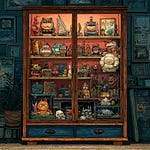There’s a modern fantasy - derived from more ancient ones - that, soon, we will be able to upload our brains to the cloud and exist in blissful immortality. In 2018, tech darling de-jour Sam Altman paid a startup called Nectome $10,000 to preserve his brain upon his death, and upload it to the cloud to presumably carry on being Sam Altman. I’m all about taking moonshots, but this is distinctly weird. Then again, the world is a weird place.
The fantasy is born out of John von Neuman’s “Technological Singularity” (also referred to as the rapture for nerds), whereby artificial intelligence reaches a stage of ever-faster, recurrent, self-reinforcing learning that leads to an explosion of new superintelligence across the universe. In this vision, humanity is left behind. Our puny, skull-bound wetware just can’t keep up, and so we’re consigned to second class citizenry or simply desposed of like rats.
Apocalyptic visions of the singularity were revived with gusto when ChatGPT started spitting out essays last year. Altman, as close to the coal-face of AI research as one could be, might have been anticipating the rapture himself when he invested in Nectome; if you can’t beat the superintelligence, you may as well join it (or be it, in this case). If you’re catching a cynical tone, trust your in stincts. There’s something compelling about a rapture, about the inevitably of needing to leave one’s earthly problems and running to a higher power that sounds a touch dehumanising. The ‘brain-in-a-jar’ mythology sounds more like someone running from their mind than seriously trying to solve the world’s problems.
Consciousness in a Box
What exactly is it that we might be trying to escape? Conscious experience is a strange thing to pin down - witness humanity’s attempts across many ages to describe it. Hindus, for example, saw people as waves on an ocean of consciousness, expressions of the same ultimate cosmic substance called Brahman. Enlightenment thinkers, in typical western fashion, variously saw the mind as a consequences of something called the ‘will’, manifestations of thought that precluded concepts, or as Decarte’s mind/body dualism. To be fair to us, consciousness is hard to study. They don’t call it the hard problem for nothing.
It is hard because I cannot see into your experience, and so you will always remain a beautiful mystery regardless of how many catch-ups over coffee we enjoy. To illustrate why this might be a problem for brain-in-a-jar folks, imagine two boxes. Hidden from view is their circuitry, but you know one is a machine made of neural networks, and the other is made of biological brains. Both of them are fed the same input and have a corresponding identical output - energy goes in, and both boxes say hello. From your perspective, they may as well be the same thing. Only one of them, though, is self-conscious, and knows what it means to feel-like-something to itself.
We cannot see the thing-in-itself, only its neuro-correlates. There is often an assumption made by many technologists and scientists that these neuro-correlates equate or give rise to conscious experience. In other words, if you can string together enough neurons connected by eletrically-charged synapses, you will have a functional, conscious brain. You are, in other words, the sum of your physical constituents. This harks back to the work of behavioral psychologist pioneer B.F Skinner and his groundbreaking experiments with reward functions. Skinner believed that we are simply response machines, receiving inputs and reacting automatically, an idea called behaviorism. Such machines can, of course, be simulated just by replicating their response mechanisms. We are our behavior, nothing more.
I think consciousness is far more interesting than that.
Giving Brains Their Due
Let’s take a moment and give our brains some credit. Rather than been made of discrete bits like computer code, the brain is locked into the sense-data of reality around the clock, like a needle on a very long record player. Digital worlds are built with transistors, tiny logic gates that turn on and off in a binary manner. Each transistor creates complex logic by connecting with several adjacent transistors. String many transistors together, and you can create increasingly complex computational circuits. A very good microprocessor will contain about 134 billion transistors.
Your brainly equivalent is the neuron, which contains an axon for outputs and dendrites for inputs. These neurons are woven together by synapses. A sugar-cube sized chunk of your brain houses more than a hundred million neurons and a trillion synapses. To simulate such an astonishing capacity for complexity, we need to know exactly how these connections map. We need to understand how one neuron connects to every other one via its axon, every decision tree, every path, every destination those electrical signals are sent to in order to replicate each thought and action we are capable of in a given moment. Obviously, too, our brain is much larger than a sugar cube. We have a half-million kilometers of wiring to unspool for the simulation, not to mention how this wiring weights its neuronal firing in concert with a fully-functional nervous system attached.
This is many thousands of petabytes already, but we also have bodies. The brain cannot simply be lifted from your spinal chord, connected as it is by your brain stem, and the many dependencies our actual conscious experience has with the rest of our body. The brain didn’t evolve in a jar; it evolved with the rest of the organism and its environment. This is not to say it can’t be done. We mapped a round-worm’s brains in 1986 (they have 302 neurons), and we expect to map a mouse’s before 2030 (about the size of a kidney bean, still smaller than a sugar cube).
But this still doesn’t suggest Sam Altman’s resurrection will be him. Even if we map his brain correctly, how will we know the box is conscious? Our brains deserve credit not just for their complexity, but for gifting us the weirdest and most beautiful gift of all - simple awareness that we are alive and reflecting the world we occupy.
Augmentation > Replacement
I’m less skeptical of augmentation. There are neural processes that technology can improve or even fix, and we should pursue these avenues of flourishing with aggression. Perhaps the most striking example is Neura-Link’s chip implant that let patients operate a screen with brain waves. Less obvious are social technologies - like institutionalised education - that have already augmented our collective intelligence and abilities to delve still further into the complexity of reality.
Augmentation is great. I’ve written these words with several tabs on my browser open to help introduce salient facts and make sure I’m not spouting too much rubbish. But I detect in some of the pronouncements of tech-evangelists a tinge of denial. Tech investor Jaan Tallinn, the co-founder of Skype, opined “involuntary death is clearly morally bad, which makes the quest for longevity a morally noble thing to engage in.” I admire the quest for longevity, and the many investments by the rich in companies that seek to vanquish our maladies. This is helping to solve the world’s problems.
Still, I’m not entirely sure involuntary death is immoral. Even the immortal Elves of Middle Earth grew weary of the world. Replacing our mortality with immortality would change our relationship with our selves. When I consider my life, everything worth collecting along the way came from a struggle, a game I concocted against the forces of reality and somehow overcame. As I grow older and become more familiar with my mortality, it strikes me that these games are more than games - the struggle is my life. With each challenge from work, creativity, romance, comes deeper self-understanding, and I can see that peace is never over some horizon, but only here with me now.
Tech billionaires get to play greater games than I do. They’ve earned it. I imagine, though, that sometimes it must feel a little boring to have won at business so absolutely, and wonder if this was it. Like Lukas Mattson, maybe they get bored and crave failure. Maybe some ennui creeps in, some shadow arriving unannounced to whisper some ambiguous, unfinished business. In “The Immortal”, Jorge Luis Borges presented death as the catalyst for what we call our lives, the games we choose to play for ourselves, the thing-in-itself inside the box, making things up in order to struggle, the better to understand what it is. In the end, we want to live longer only to appreciate it’s brevity all the more.
An immortal you, after all, would not be you.
Coda
I’m sitting on my favorite corner and my coffee is at my feet, the butter I put in every single one slowly separating and drifting to the corners of my cup like a sunny iceberg. The ordinariness of it all is warm popcorn on a drizzly day. I have my routines and though I like to break them up now and then, this one I probably never will. Abruptly a guy across the street loudly asks “Siri, how many milliseconds in a year” and I look up and wonder why you’d ask it so loud unless you were sharing Siri’s answer with the whole street. Siri gurgles the answers up - it’s muffled by the rain - but then I see his daughter at his knees on a bike and she’s clapping her hands in delight. I know it was a performance now, and I know he was showing her how marvelous things are.















